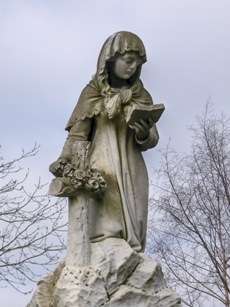 |
 |
 |
Glasnevin CemeteryOriginally known as Prospect Cemetery, Glasnevin is Ireland's largest burial place
Conception and significanceThe cemetery was the 'brain-child' of Daniel O'Connell, the Liberator, who lies buried beneath its most conspicuous architectural feature: a round tower, the tallest in Ireland. O'Connell campaigned for the repeal of oppressive anti-Catholic laws, among them laws that denied Catholics the right to bury their dead according to their own religious rites. Back in the early 1800s, Roman Catholics were not even allowed their own burial grounds. So Glasnevin, with its non-denominational status approved, was a significant step forward.
It became the first graveyard where both Catholics and Protestants could be assured a dignified and appropriate burial service.
Genealogical valueRecords for each individual burial at Glasnevin cemetery since 1832 have survived. The registers detail full name and address of the deceased, cause, date and location of death, and name and address of the informant. The exact site of the grave is also given. While this can be accurately located, it does not necessarily indicate that there is a headstone. Some three-quarters of those buried at Glasnevin Cemetery are in unmarked graves.

Michael Carey, the 11-year-old son of Michael and Bridget Carey, was the first to be interred at Glasnevin cemetery. The records for Glasnevin are available online, together with those of four Dublin cemeteries run by the Glasnevin Trust (which collectively date back to 1828), and can be searched for a fee at the Glasnevin Cemetery/Genealogy website. Two types of genealogy search can be made. The first is for a single named individual, the other is for an extended search, for a named individual and all those buried in the same grave. Further enhancements to the online search facility were made in April 2013 when the website was fully revamped.
Design and artistic legacyIt was designed to be a garden cemetery, a style which had become fashionable since Pere Lachaise opened in Paris in 1804. As such, the initial land area of 9 acres (now 128 acres) was carefully laid out rather than being allowed to evolve naturally, as most graveyards around churches had done.
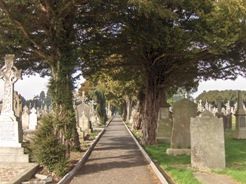
While its principal objective was to bury people, it was also designed to be a place to wander and to enjoy the architecture and sculpture. Because of its prestige, artists were happy to accept commissions and use the cemetery as an outdoor gallery for their skills. Among the artists who created sculptures was James Pearse, the father of Padraig and Willie who were executed after the 1916 Uprising.
History and developmentThe first burial at Glasnevin Cemetery was of 11-year-old Michael of Frances Street, Dublin. At this time, ten men were employed for maintenance and digging and a grave was dug using long handled shovels and spades with 18-inch blades. The first grave on a plot was dug to a depth of twelve feet, which took up to eight hours, while second or later, shallower graves took at least three hours of hard toil.
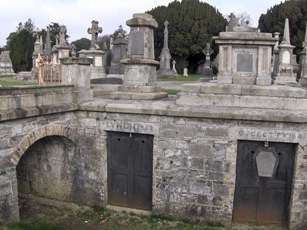
Special areas were also created for victims of the many epidemics or outbreaks (of smallpox (1871-2), cholera (1865-66) or typhoid (1846-49)) that occasionally killed off large numbers of Dubliners in short periods of time. The last such outbreak, the Influenza Epidemic of 1918, saw 240 funerals at Glasnevin Cemetery over an eight-day period. The norm would have been twelve or thirteen. As the cemetery grew, distinct burial areas were also created for certain groups of people. There is a plot for the College of Surgeons, for example, and a number of areas are reserved for members of certain religious groups such as the Jesuits or Dominican Friars. Probably the most famous area is the Republican plot where many of those who were killed or executed for their part in achieving Ireland's freedom are interred.
|
Glasnevin wins top AwardOn 1 December 2011, the Glasnevin Trust received the 2011 Award for Excellence in Genealogy from the Council of Irish Genealogical Organisations (CIGO). The Award, which was presented by the Minister for Arts, recognised the outstanding database developed by the Trust of its 1.5million burial records.
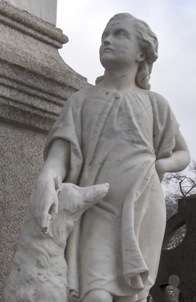
Glasnevin CemeteryGlasnevin CemeteryFinglas Road Dublin 11 Tel: +353 (0)1 882 6550 Museum: +353 (0)1 882 6550 In 2010, Glasnevin Museum opened. It won an international THEA award for Themed Entertainment in March 2011, the first cemetery to do so. It contains the City of the Dead exhibition, which covers burial practices, religious beliefs and record keeping, and the Milestone Gallery, a tribute to the cemetery's founder, Daniel O'Connell, and some of the renowned people buried here. Tours of the cemetery take place up to three times daily.
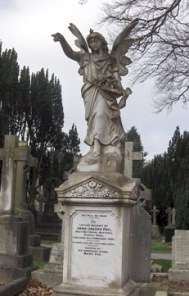
|
|
|
|
||
|
| Home Page | Disclaimer | Contact |Sitemap|Privacy Policy|
By Claire Santry, Copyright©
2008-2020 Irish-Genealogy-Toolkit.com. Dedicated to helping YOU discover your Irish Heritage.
|
||
